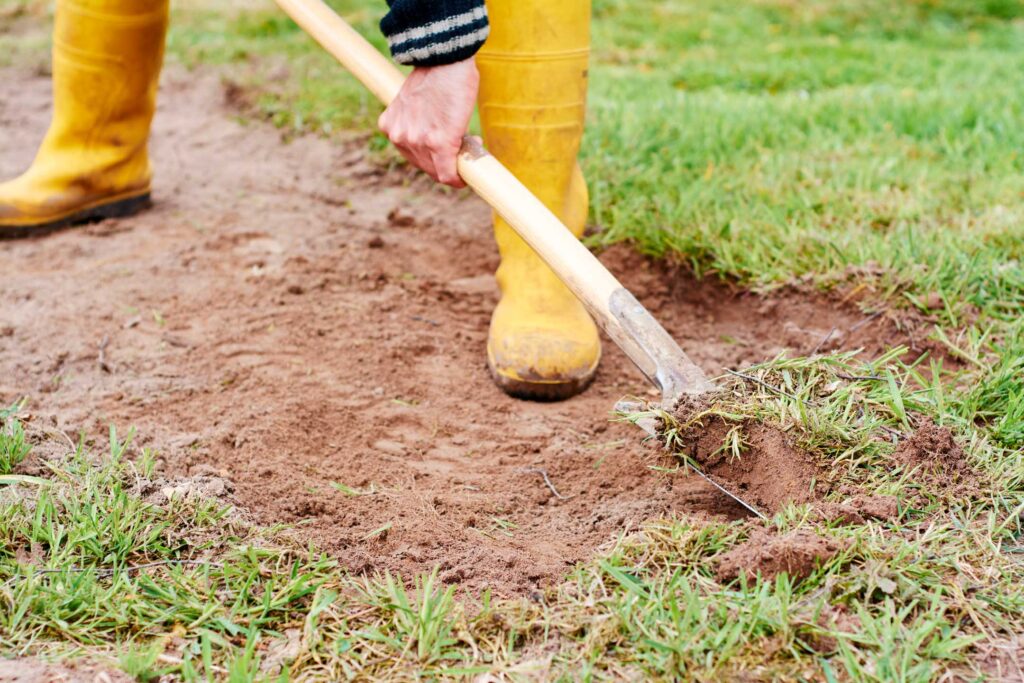
Gardner removing turf of a meadow to turn it into a vegetable garden plot.
Is your lawn turning into a field of tiny spiky enemies? If stepping outside barefoot feels like walking on nails, you’re probably dealing with the dreaded grass burrs. These sharp, sticky seed pods—also called grass stickers—are a nightmare for homeowners and pets. Thankfully, there are reliable and effective solutions that can bring relief.
Let’s explore smart and practical methods for grass burr removal so you can take back control of your lawn.
What Are Grass Burrs and Why Do They Appear?
Grass burrs, also known as sandburs or grass stickers, are aggressive weeds that thrive in dry, sandy, and neglected soil. Their seeds are designed to stick, making them tough to avoid and even tougher to get rid of.
They flourish in poorly maintained lawns, especially during hot weather. If not treated early, they spread quickly and become a yearly nuisance. The good news? You can get rid of them with the right approach and consistency.
Why Timely Grass Burr Removal Matters
Early intervention is key. Left alone, grass burrs can take over your lawn and outcompete healthy grass. They’re painful to step on, can get stuck in your pets’ fur, and are difficult to remove from clothing.
Effective weed burr removal stops their life cycle. The goal is to eliminate existing burrs and prevent new ones from forming. Without control, they will return every season, worse than before.
Manual Removal: The First Step
One of the first things you should do is remove burrs by hand or with tools. Here’s how:
- Wear gloves and use a rake: Rake up visible burrs in the early morning when dew helps them stick together.
- Use a weed puller: For small patches, use a weeding tool to pull them out by the root.
- Dispose properly: Bag the burrs and discard them in the trash, not compost.
Manual removal is tedious but helps reduce the spread significantly.
Mowing and Lawn Maintenance Tips
Regular mowing helps weaken grass burr plants by preventing seed production. However, mowing must be done correctly:
- Never mow too short: Cutting too low stresses healthy grass and allows burrs to spread.
- Keep blades sharp: Dull blades can tear the grass and damage the lawn.
- Bag your clippings: Don’t mulch grass if burrs are present—it spreads the seeds.
Healthy lawns naturally resist weed growth, including grass stickers.
Using Pre-Emergent Herbicides
Apply a pre-emergent herbicide in early spring before grass burr seeds start germinating. Choose one labeled specifically for burr control.
Tips for success:
- Apply when soil temperatures hit 52–55°F.
- Water the lawn lightly after application.
- Reapply every 6 to 8 weeks during peak seasons.
This step prevents burrs from taking root in the first place.
Applying Post-Emergent Herbicides
Already seeing burrs? Use a post-emergent herbicide to target existing plants. This method is effective when burrs are actively growing.
Best practices include:
- Spray during calm, dry weather to avoid drift.
- Use selective herbicides to avoid harming turf grass.
- Always follow label directions for safety.
This technique helps in direct grass burr removal once they’ve appeared.
Boosting Soil Health to Keep Burrs Away
Weeds love poor soil. Improve your lawn’s soil condition to make it less inviting for grass burrs.
Do the following:
- Aerate the lawn annually.
- Fertilize based on a soil test.
- Water deeply and less often to build strong roots.
Strong, dense grass leaves no room for grass stickers to thrive.
Try Natural Remedies for Organic Lawns
If you prefer eco-friendly options, some natural methods work too.
- Corn gluten meal: A natural pre-emergent that also adds nitrogen.
- Boiling water: Useful for small patches but not ideal for large lawns.
- Vinegar and salt: Kills weeds but may harm your grass—use with caution.
These methods are great for spot treatments and safer for kids and pets.
Dealing With Burrs in Pastures or Larger Areas
Larger areas like pastures need different care. Consider:
- Using grazing animals like goats who eat weeds.
- Planting competitive grasses like Bermuda or Bahia.
- Hiring professionals for large-scale grass burr removal treatments.
Maintenance is more intense for larger properties, but prevention works wonders long term.
The Role of Mulch and Ground Covers
In garden beds or between stones, mulch can help keep burrs at bay.
- Use thick mulch layers to block sunlight.
- Landscape fabric under gravel or stones also stops seed growth.
- Check often for burr sprouts and remove early.
Ground covers reduce open space, denying burrs a chance to root.
Don’t Forget to Clean Up After Yard Work
After mowing or working on the lawn:
- Clean mower blades and tools to avoid spreading burrs.
- Check clothes, shoes, and pet fur for burrs.
- Dispose of yard waste quickly and properly.
These small steps prevent burr re-infestation from unnoticed seeds.
Final Tips for Long-Term Grass Burr Removal
Want lasting results? Combine multiple techniques. Use herbicides early, mow regularly, improve soil, and pull visible burrs.
Make weed burr removal part of your regular lawn care routine. The more consistent you are, the fewer burrs you’ll deal with year after year.
Conclusion
Grass burrs can turn a beautiful lawn into a painful, prickly mess. But with the right approach, you can tackle them effectively and enjoy a burr-free yard. Focus on a balanced strategy: start early, stay consistent, and use both manual and chemical options when necessary. Always maintain your lawn with good practices that promote healthy, dense turf. Over time, these efforts will pay off. Your yard will be safer, cleaner, and more enjoyable for everyone.
Take control of your yard today! Use these expert grass burr removal tips and enjoy a safer, cleaner lawn free from prickly surprises.


